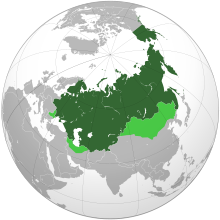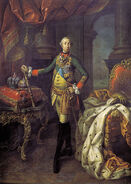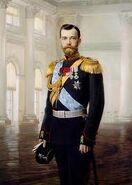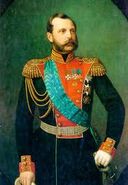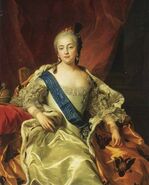(→Territorial History: Wrong year for taking the Crimea >:() |
No edit summary |
||
| Line 83: | Line 83: | ||
===Diplomatic Status=== |
===Diplomatic Status=== |
||
| − | *<span style="line-height:18px;white-space:pre-line;">The Empire of Morocco ( |
+ | *<span style="line-height:18px;white-space:pre-line;">The Empire of Morocco (Rik II): ''Allied, very friendly.''</span> |
*The Commonwealth of Poland-Lithuania (Charles VII): ''Allied, very friendly'' |
*The Commonwealth of Poland-Lithuania (Charles VII): ''Allied, very friendly'' |
||
*The Kingdom of Hungary (Jeremiah V): ''Allied, friendly'' |
*The Kingdom of Hungary (Jeremiah V): ''Allied, friendly'' |
||
| Line 90: | Line 90: | ||
*The Republic of Genoa (Doge Ermanno): ''Allied, friendly'' |
*The Republic of Genoa (Doge Ermanno): ''Allied, friendly'' |
||
*The Holy Kingdom State of Malta (Matthew IV): ''Allied, friendly'' |
*The Holy Kingdom State of Malta (Matthew IV): ''Allied, friendly'' |
||
| ⚫ | |||
*The Feudalistic Kingdom of Japan (Buru I): ''Allied, indifferent'' |
*The Feudalistic Kingdom of Japan (Buru I): ''Allied, indifferent'' |
||
*The Kingdom of Belgium and Northern France (James I): ''Allied, indifferent'' |
*The Kingdom of Belgium and Northern France (James I): ''Allied, indifferent'' |
||
| ⚫ | |||
*The Kingdom of Portugal (Grace I): ''Neutral'' |
*The Kingdom of Portugal (Grace I): ''Neutral'' |
||
*The Kingdom of France (Louis XV): ''Neutral'' |
*The Kingdom of France (Louis XV): ''Neutral'' |
||
| Line 98: | Line 98: | ||
*The Imperial Kingdom of Qing (Sheng I): ''Neutral'' |
*The Imperial Kingdom of Qing (Sheng I): ''Neutral'' |
||
*The Kingdom of Prussia (Frederick II): ''Neutral'' |
*The Kingdom of Prussia (Frederick II): ''Neutral'' |
||
| − | *The Kingdom of Great Britain and Ireland (George II): ''Netural |
+ | *The Kingdom of Great Britain and Ireland (George II): ''Netural'' |
| − | *The Turkish Caliphate of the Ottoman Empire (Ahmed IV): '' |
+ | *The Turkish Caliphate of the Ottoman Empire (Ahmed IV): ''Enemies'' |
*The Persian Caliphate of the Safavid Empire (Abbas III): ''Enemies'' |
*The Persian Caliphate of the Safavid Empire (Abbas III): ''Enemies'' |
||
| Line 159: | Line 159: | ||
*''His Imperial Majesty The Emperor and Autocrat of all the Russias Vladimir Petrovich Romanov I'' |
*''His Imperial Majesty The Emperor and Autocrat of all the Russias Vladimir Petrovich Romanov I'' |
||
*''His Imperial Majesty The Crowned Prince of all the Russias Ivan Vladimirovich Romanov VI'' |
*''His Imperial Majesty The Crowned Prince of all the Russias Ivan Vladimirovich Romanov VI'' |
||
| + | *''His Imperial Majesty Prince Devid Vladimirovich Romanov I'' |
||
| + | *''Her Imperial Majesty Princess Elizaveta Vladimirivna Romanov II'' |
||
===Russian Imperial Court=== |
===Russian Imperial Court=== |
||
| Line 365: | Line 367: | ||
</div> |
</div> |
||
| + | |||
{{PSD}} |
{{PSD}} |
||
[[Category:Fan Creations]] |
[[Category:Fan Creations]] |
||
Revision as of 03:17, 24 July 2013
The Empire of Russia (Императорский царизма в России), is a country in northern Eurasia. With the largest empire in the world, Russia is a respected world power with a unique culture and society.
The Tsardom of Russia's leadership is a constitutional monarchy, in which the emperor (tsar) exercises supreme power with heavy influence from a legislation. Emperor Vladimir I (Vladimir Petrovich Romanov) is the current monarch of Russia. The heir to the crown is the Emperor's son, the tsarevich, Ivan VI (Ivan Vladimirovich Romanov). The Prime Minister of Russia, who has limited power beneath the Tsars, is Corovin Akimivich Romanavinski.
In 1721, Tsar Peter I of the Tsardom of Russia officially converted the tsardom to the Empire of Russia following the Treaty of Nystad. Although, officially, all monarchs of Russia are to hold the title "Emperor of Russia", the ceremonial and traditional title of "tsar" is still commonly, yet incorrectly, used.
Tsar Peter I's son, Vladimir, soon arose to the throne in 1744. Following his reign was a line of various emperors, in order: Ivan VI, Venyamin I, and Gabriel I. Following the abdication of Gabriel I, Vladimir I once again rose to power and continues to rule as emperor.
The Empire of Russia
Political Status
- Official Name: The Imperial Diarchic Empire of Muscovy and All the Russias
- Abbreviated Name: The Russian Empire
- System of Government: Constitutional Monarchy
- Head of State(s): Vladimir I
- Head of the Legislature: Corovin Akimivich Romanavinski
- Imperial Capitol: Sankt-Peterburg
- Executive Branch: Autocratic reign by the Emperor
- Legislative Branch: Unicameral Parliamentarian Legislature (the Boyar Duma); Influence from the Tsars' elected cabinet of advisers, the Royal Imperial Court; ran by elected prime minister
Economic Status
- Networth Income:
R5,200,000,000 (£192,000,000) - Currency: Russian Ruble (
P) - System of Economy: Free Market / Autarkic Agricultural (Serfdom)
- System of Trade: Mercantilistic
- Major Exports (Agricultural): Wheat, timber, rye, muslin, precious metals (esp. zinc, copper, iron, diamond,)
- Major Expots (Industrial): Textiles, limestone, fishing, weaponry / armour, alcoholic beverages
Social Status
- Population: 45,850,000 (estimated 1745 census)
- Primary Nationalities: Russian (60%), Ukrainian (15%), Polish (8%), Lithuanian (7%), Scandanavian / Nordic (5%), Roumanian (4%), Mongolian / Chinese (1%)
- Primary Ethnicities: Russian (Slavik / Baltic) (47%), Cossak / Crimean / Moldavian (20%), Tatar (12%), Caucasian (Armenian / Georgian / Azerbaijani) (9%), Turkic (Kazakh / Turkmen / Kyrgyz / Tajik / Uzbek) (7%), Mongol / Manchurian (2%)
- Primary Languages: Russian (official), French (widely spoken by nobility), Ukrainian, Polish, Finnish, Estonian, Turkish, various other indigenous tongues
- Primary Religions: Russian Orthodox (official), Roman Catholicism, Armenian Catholicism, Judaism, Lutheran, Zoroastrianism, Islam, Karaites, various other indigenous pagan faiths
Military Status
- Total Military Personnel (active): 1,375,000 (estimated 1745 census)
- Total Military Personnel (reserve): 890,000 (estimated 1745 census)
- The Grand Army of the Tsar total: 950,000 (660,000 infantry, 210,000 cavalry, 80,000 artillery)
- The Grand Navy of the Tsar total: 425,000 (364,000 marines, 61,000 seamen)
- The Grand Navy of the Tsar strength: 585 (253 frigates / destroyers, 189 sloops / gun-brigs, 72 post-ships, 71 ship-of-the-lines)
- Current Conflicts / Foreign Interventions: Isolation of Spain; minor military outposts in Romania, Poland-Lithuania, Prussia, Sweden, and Malta
Diplomatic Status
- The Empire of Morocco (Rik II): Allied, very friendly.
- The Commonwealth of Poland-Lithuania (Charles VII): Allied, very friendly
- The Kingdom of Hungary (Jeremiah V): Allied, friendly
- The Kingdom of the Netherlands (Jarod I): Allied, friendly
- The Kingdom of the Swiss Confederacy (William II): Allied, friendly
- The Republic of Genoa (Doge Ermanno): Allied, friendly
- The Holy Kingdom State of Malta (Matthew IV): Allied, friendly
- The Kingdom of Joseon (Yeongjo I): Allied, friendly
- The Feudalistic Kingdom of Japan (Buru I): Allied, indifferent
- The Kingdom of Belgium and Northern France (James I): Allied, indifferent
- The Kingdom of Portugal (Grace I): Neutral
- The Kingdom of France (Louis XV): Neutral
- The Kingdom of Austria (Hannah I): Neutral
- The Imperial Kingdom of Qing (Sheng I): Neutral
- The Kingdom of Prussia (Frederick II): Neutral
- The Kingdom of Great Britain and Ireland (George II): Netural
- The Turkish Caliphate of the Ottoman Empire (Ahmed IV): Enemies
- The Persian Caliphate of the Safavid Empire (Abbas III): Enemies
The Russian Empire
Map of the Russian Empire
Major Russian Protectorates
Europe
- Königsburg
- Pomerania
- Montenegro
- Holstein-Gottorp
- Schleswig
- Moldavia
- Serbia
- Kosovo
Asia / Middle East
- Palestine
- Kyrgyz
- Tajiki
- Uzbek
- Turkmen
- Mongolia
- Sakhalin
- Heilongjiang
- Siam
Americas
- Alaska
- Yukon
- Nunavit
Territorial History
The following acquisitions all occurred under Emperor Vladimir I
- April 22, 1745: Russia invades and briefly occupies Prussia, before granting independence
- June 3, 1745: Russia invades and annexes Mongolia
- June 20, 1745: Russia purchases and annexes Siam
- June 30, 1745: Russia trades Armenian and Circassian land to Ottoman Empire for Cyprus
- July 27, 1745: Russia purchases and annexes the free Balkan state of Montenegro
- September 20 - October 10, 1745: A series of expeditions and Russian claims in the Siberian islands
- October 21, 1745: Tatar states of Kyrgyz and Tajik conquered and annexed
- November 15, 1745: Russia purchases and annexes the state of Serbia from the Ottoman Empire
- November 16, 1745: A deal among Russia, Ottoman Empire, and Poland-Lithuania in which the latter is granted independence, and Russia gains Palestine from the Ottoman Empire
The following acquisitions all occurred under Emperor Ivan VIII
- Februrary 2., 1746: Great Britain declares war on Russia
- Februrary 3, 1746: Great Britain invades Russia; later pulls out troops and returns independence to Russia
- February 15, 1746: Negotiations are held with leader of Spain, Pearson Wright; no progress made
- February 15, 1746: Spain invades Russia; Russia declares complete isolation from Spain, exiling leader Pearson Wright into Serbia
The following acquisitions all occurred under Emperor Gabriel I
- Feburary 19, 1746: Tensions settle, the Qing Dynasty and the Russian Empire are officially one and under Emperor Gabriel I
The following acquisitions occurred under Emperor Vladimir I
- June 18, 1746: Following Emperor Gabriel's abdication, Vladimir I once again resumes the title of emperor
- The Qing Dynasty of China is returned to Emperor Sheng, following his abdication from Russia
Governmental and Royalty Officials
Russian Royal Family
- His Imperial Majesty The Emperor and Autocrat of all the Russias Vladimir Petrovich Romanov I
- His Imperial Majesty The Crowned Prince of all the Russias Ivan Vladimirovich Romanov VI
- His Imperial Majesty Prince Devid Vladimirovich Romanov I
- Her Imperial Majesty Princess Elizaveta Vladimirivna Romanov II
Russian Imperial Court
- Head of the Imperial Court (Prime Minister) --Corovin Akimivich Romanavinski
- Speaker of the Court (Lord Chancellor) -- N/A
- Minister of War -- N/A
- Minister of the Interior -- Venyamin Makmorgn
- Minister of Religion -- N/A
- Minister of Finance -- N/A
- Minister of Navy -- N/A
- Minister of Defense -- N/A
Russian Orthodox Church
- Primate of Moscow -- Ivan Vladimirovich Ramonov VI
- Bishop of St. Petersburg --
- Bishop of Kazan --
- Bishop of Novgorod --
- Bishop of Kiev --
Foreign Ministers
- Ambassador of England and Ireland -- Andrew Norrington Mallace
- Ambassador of Prussia -- Matthew Antonius
- Ambassador of Romania -- Reyes de Luz
Grand-Dukes
- Grand-Duke of Courland -- Marc Cannonshot
History
Previous Tsars
- Ivan IV (1547 - 1584); House of Rurik
- Fyodor I (1584 - 1598); House of Rurik
- Boris I (1598 - 1605); House of Godunov
- Fyodor II (1605); House of Godunov
- Dmitri II (1605 - 1606); House of Godunov
- Vasili IV (1606 - 1610); House of Rurik
- Mikhail I (1613 - 1645); House of Romanov
- Alexei I (1645 - 1676); House of Romanov
- Fyodor III (1676 - 1682); House of Romanov
- Ivan V (1682 - 1696); House of Romanov
- Peter I (1692 - 1725); House of Romanov
- Venyamin I (1725 - 1735); House of Romanov
- Andrei I (1735 - 1744); House of Volkov
- Vladimir I (1744 - 1746); House of Romanov
- Mikhail II (1744 - 1745); House of Volkov
- Ivan VI (1746 - 1746); House of Romanov
- Venyamin II (1746 - 1746); House of Romanov
- Gabriel I (1746 - 1746); House of Volkov
- Vladimir I (1746 - ); House of Romanov
Russian History
Early Slavic Inhabitant and the Kievan Rus
Russia's history dates back to the 9th century A.D., when Slavic traders from north-eastern Europe known as Varangians gained access to the Russian mainland via the Baltic Sea. Upon further exploration into the land, the Slavs established trading cities throughout, most notably Novgorod. Upon venturing further south into the Black Sea and Caspian Sea regions, the Varangians established more cities, including Kiev. Eventually, these cities prospered over time, and adapted their own governments. These governments acted as independent states, called a "Rus". In 882, the Kievan Rus was founded, and the first line of grand dukes entered the Kievan Golden Age. Within the next centuries, more city-states would emerge, including the Grand Duchy of the Moscovy Rus, the Kazan Rus, and the Novgorod Rus.
Mongol Conquest
In the late 12th century, land in the east, mostly inhabitated by the Islamic Tatar tribes, fell under command of the Golden Horde, the portion of the Mongol Empire led by Temujin "Genghis" Khan. As the Mongol Empire expanded, the Golden Horde's influence, under different leaders, eventually crossed the Ural Mountains (acting as a boundary between Europe and Asia) and gained a hold on the governing city-states in the west. By the 1300s, nearly all of Russia had fallen into Mongolian-Tatar control.
Rise of the Tsar
During the 15th century, the Russian city-states lay in harsh turmoil. In 1547, however, Tsar Ivan IV (the "Terrible") led a revolt on the oppresive Mongols, and eventually freed western Russia from their rule. The same year, Ivan IV united all the freed Russian city-states, and declared himself first Tsar (Caesar) of "all the Russias". During his long reign (1547-1584) Ivan IV nearly doubled the already expanding Russian Tsardom, established a strong central government (including the a parliamentarian figure, the Russian Imperial Court), and established the Russian capital in the Moscovy Rus, now called Moscow.
The Romanov Dynasty
However, Russia's progress soon declinded due to a line of weak rulers, and continuing wars with Poland-Lithuania, Sweden, the Crimean Khanate (a final incarnation of the Golden Horde), the Byzantine Empire, Persia, and the Ottoman Empire respectively. However, by the mid 1600s, Tsar Mikhail I came to power in Russia, and began a lasting dynasty known as the Romanov rule. Under the Romanov leaders, Russia conquered foes such as the Ottoman Empire and Persia, increased its size further, and improved the military with the addition of the Cossacks, noble yet zealous warriors hailing from the Ukrainian steppes. During this time, Russia also gained control of most of Ukraine (in addition to Kiev), after the Russo-Polish War.
Peter the Great
By the close of the 17th century, Russia had emerged as a world power, yet seemed isolated from the rest of the western world. In 1682, Tsar Peter I "the Great" came to power in the Tsardom of Russia. Under his rule, Russia would not only accomplish significant victories against Sweden and Poland-Lithuania in the Great Northern War, but would also be launched into a "cultural revolution". Under Peter the Great, art, literature, architecture, science, and music fluorished in Russia, awarding them membership into the western world. Perhaps Peter I's greatest achievement, though, was the construction of St. Petersburg on the Baltic Sea in 1723. The city, the site of a captured Swedish fort, not only became the new Russian capital, but also a world mecca of culture, earning it the nickname the "Venice of the East".
In 1745, after the resignation of Tsar Andrei I, Tsar Mikhail II, the true heir to the throne, took over. Only days after his rule, though, he handed power over to a close friend and native Briton Vladimir I. However, after a breakdown by Tsar Vladimir I due to high pressure by numerous nations, he handed the throne down to his son, Tsar Ivan VIII. Later Tsar VIII invited former Tsar Venyamin I to hold the throne with him. Russia is now a diarchy.
Largest Cities
Below are the thirty largest cities (by population) within the Russian Empire. Poland, Belorus, and Lithuania are included, while Prussia and protectorates in Finland and Portugal are excluded.
| City (Russian) | City (English) | Population |
|---|---|---|
| Санкт-Петербург | St. Petersburg (Sankt-Peterburg) | 1,264,900 |
| Москва | Moscow (Moskva) | 1,038,600 |
| Киев | Kiev (Kyyiv) | 626,000 |
| Одеса | Odessa | 314,000 |
| Kazan | Kazan | 282,200 |
| Лодзь | Łódź (Lodzh) | 247,700 |
| Рига | Riga | 174,000 |
| Харьков | Kharkov (Kharkiv) | 159,600 |
| Тбилиси | Tbilisi (Tiflis) | 154,500 |
| Саратов | Saratov | 147,100 |
| Ростов-на-Дону | Rostov-on-Don (Rostov) | 140,000 |
| Тула | Tula | 124,700 |
| каракуль | Astrakhan | 122,900 |
| Екатеринославе | Yekaterinoslav (Dnipropetrovsk) | 122,800 |
| Баку | Baku (Baki) | 115,900 |
| Кишинев | Chişinău (Kishinev) | 108,500 |
| Архангельск | Arkhangelsk (Archangel) | 103,000 |
| Симферополь | Simferopol | 102,000 |
| Нижний Новгород | Nizhny Novgorod (Gorki) | 99,100 |
| крылатка | Samara (Kuybyshev) | 96,200 |
| Царицын | Tsaritsyn | 92,400 |
| Ярославль | Yaroslavl | 88,600 |
| Ивангород | Ivangorod | 75,900 |
| Таллин | Tallinn (Reval) | 74,500 |
| Каунас | Kaunas | 72,300 |
| Воронеж | Voronezh | 68,600 |
All populations obtained from 1745 census.
Government
Like nations such as Great Britain, France, and Spain, Russia is a combined-government type of a kingdom (monarchy) and an empire. In 1721, Peter the Great had converted the Tsardom of Russia into the Empire of Russia. However, rather than take on the title of "Emperor", all Russian rulers since have kept the title of "Tsar".
Russia's kingdomship is officially an enlightened diarchy, in which almost all power is limited to the two tsars. However, a portion of the power belongs to the Russian Imperial Court, a parliamentarian group of politicians who are responsible for setting laws, proposing new ideas (to be approved by the tsars), and handling foreign relations. In addition, each member of the Imperial Court specializes in a certain field (e.g., the Minister of Finance, the Minister of Religion) and act as advisers to the tsars. The Imperial Court
The Russian Empire is divided into twelve oblasts, or regions. Each oblast is governed by an imperial governor, who is hand-selected by the tsars. For a complete list of the Russian oblasts, see below.
Economy
The Russian economy is a free-market one, like all other European competitors. However, due to recent philosophies and ideologies, Russia has begun experimenting with a socialist-based economy.
Russian trade is mercantile-based. The primary trade company (owned by the Tsars and the Imperial Court) is the Russian Trade Federation, operating out of the imperial capital St. Petersburg. Other notable Russian trade cities include Arkhangelsk on the White Sea, Odessa on the Black Sea, Baku on the Caspian Sea, Magadan in the Sea of Okhotsk, and Vladivostok on the Pacific Ocean.
Though the Russian economy is ran by either of the Russian Tsars (in this case, Vladimir I), both the Minister of Finance and the Minister of Trade and Commerce, both members of the Russian Imperial Court, have a strong influence in the economy. All new taxes are to be proposed by the Russian Imperial Court, and submitted for approval to the Tsars. The Imperial Court is headed by the prime minister, who is the head of the legislative body and is immediately given all autocratic authority should both tsars be absent, ill, or killed. The succesor of the prime minister is the Speaker of the Court, who also acts as the voice of the Imperial Court.
The current Russian currency is the Ruble (also spelled Rouble). The current Russian average network income and growth revenue (as of 1745) is estimated at 5.2 billion Rubles (112 million British Schillings), making Russia the second richest nation in the world, only behind Great Britain.


